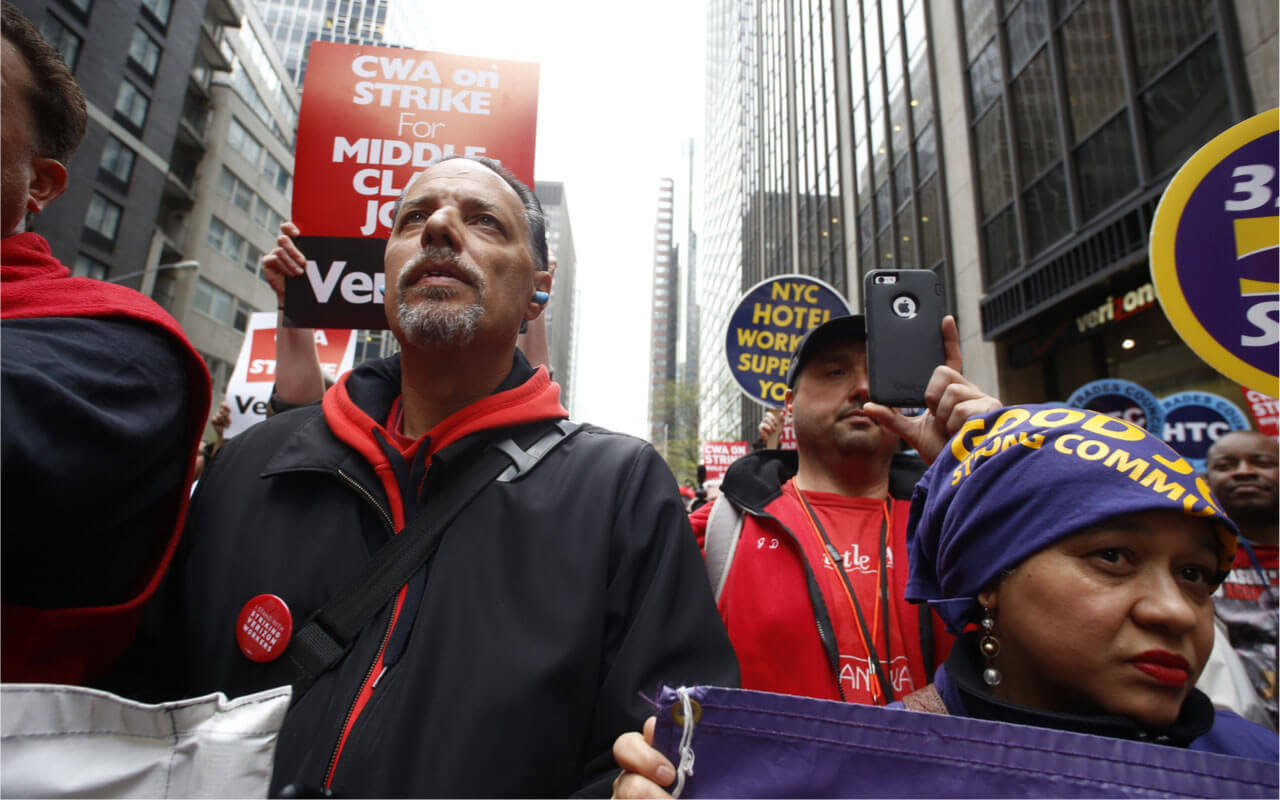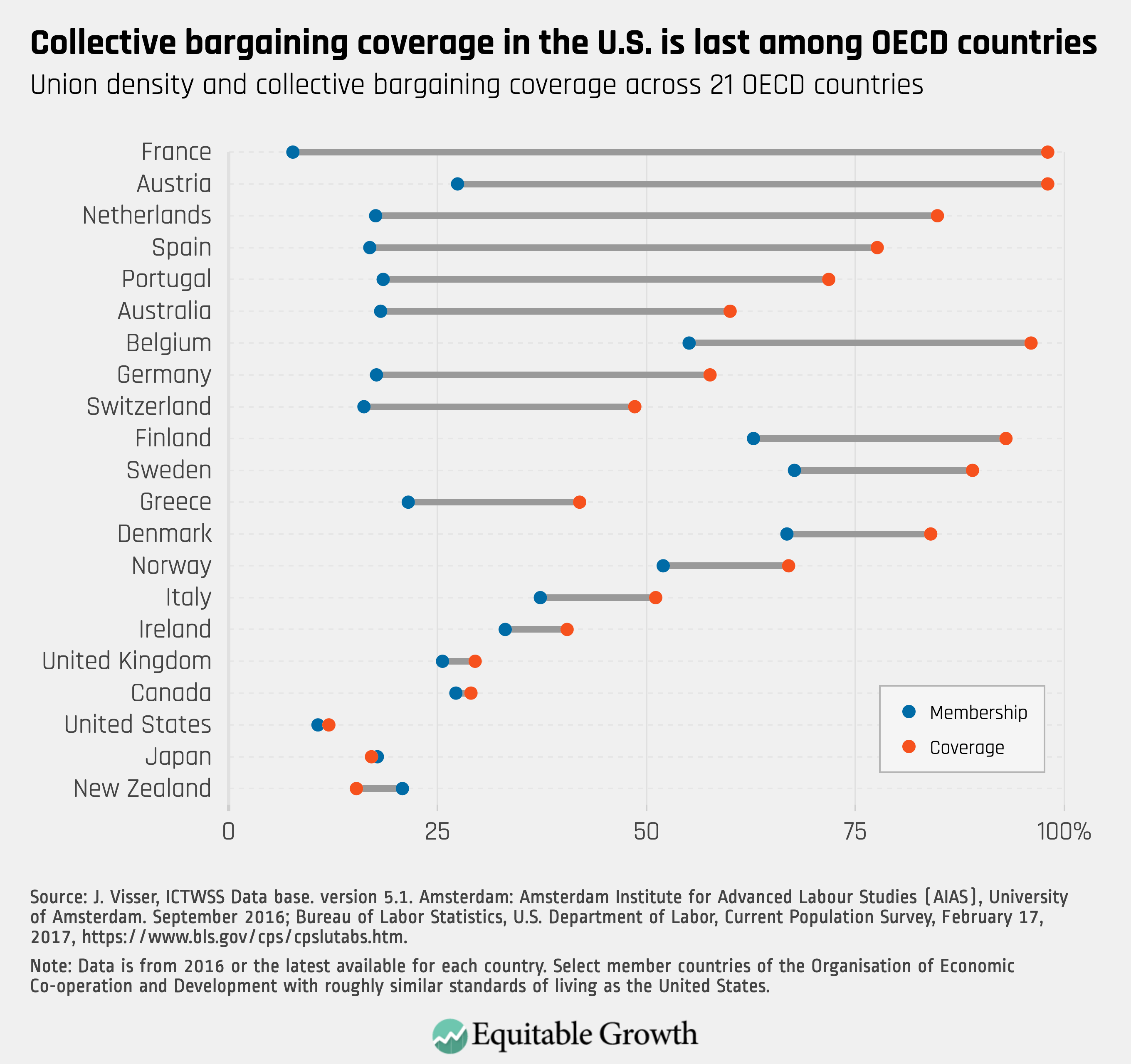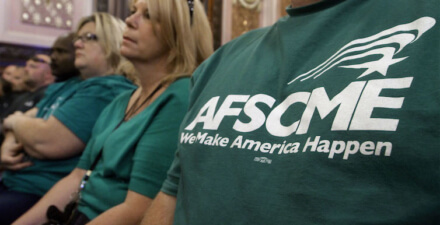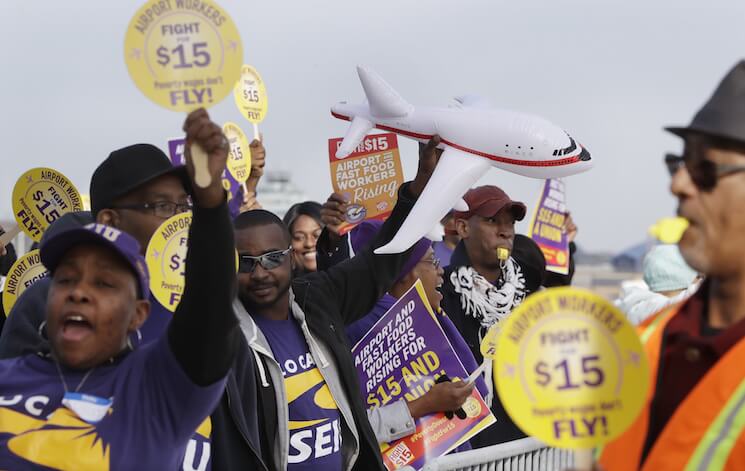Evolving worker and management attitudes toward labor organizations: The Equitable Growth context

Tomorrow, April 4, Alexander Hertel-Fernandez, a Washington Center for Equitable Growth grantee and assistant professor of international and public affairs at Columbia University, will present at an Equitable Growth seminar his new research examining worker and management preferences for specific aspects of labor organization. This research, based on original survey data, explores what workers want from labor organizations, including not only traditional unions but also alternatives that exist in other countries and are being discussed in the United States.
Research on why wages in the United States have been stagnant for several decades, how unions give workers negotiating power in labor markets, and how the decline in union membership has affected economic inequality has always been an important priority for Equitable Growth. In advance of tomorrow’s seminar, we have collected here a combination of working papers, columns, and other materials from our website that provide context for Hertel-Fernandez’s presentation.
In 2018, Equitable Growth hosted a seminar presentation by Suresh Naidu, associate professor of international and public affairs and economics at Columbia, on important new research he and his colleagues would soon publish on the relationship between union membership and economic inequality. In their working paper, “Unions and Inequality Over the Twentieth Century: New Evidence from Survey Data,” Naidu, Henry S. Farber and Ilyana Kuziemko of Princeton University, and Daniel Herbst, now of the University of Arizona, concluded that extensive survey data over a long sample period suggests that unions have had a significant, equalizing effect on the income distribution.
In 2015, “The steep path forward for unionization,” by former Equitable Growth Senior Policy Analyst Nick Bunker, discussed the impact of the decline of unionization on economic inequality and the prospects of a rebound for unions. Relying on a number of research papers, it noted that a resurgence would likely reduce inequality, but that the path forward would be steep. Looking at history, it suggested that if a resurgence were to occur, it would likely be the result of a sudden, surprising development in the economy.
In 2017, in “The challenging and continuing slide in U.S. unionization rates,” Equitable Growth Executive Director and chief economist Heather Boushey reported on annual Bureau of Labor Statistics data pointing to a continuing decline in U.S. union membership. In 24 years, union membership among workers had been nearly halved. She cited not only changes in the economy but also how difficult employers can and do make it to organize a union and deliver a first contract.
Also in 2017, former Equitable Growth Research Assistant Matt Markezich—in “Why is collective bargaining so difficult in the United States compared to its international peers?”—delved into the question of how union membership and coverage in the United States compare to those of other developed countries. As of 2016 (or the most recent data, depending on the country), the United States ranked next to last or dead last in union membership and coverage, which includes both union members and nonmembers covered by union contracts, among the member nations of the Organisation for Economic Co-operation and Development. (See Figure 1.) Among the reasons for higher levels of union coverage in other countries are more union-friendly legal frameworks and, in some cases, the administration of social insurance by unions.
Figure 1

In “Understanding the importance of monopsony power in the U.S. labor market,” Equitable Growth economist Kate Bahn considered the potential fallout from the Supreme Court’s 2018 decision in Janus v. American Federation of State, County, and Municipal Employees. She predicted that this landmark ruling could significantly weaken public-employee unions and, combined with the deterioration that had already occurred among private-sector union membership, further weaken workers’ bargaining power and contribute to monopsony. Some economists believe monopsony has played a significant role in wage stagnation in the U.S. economy.
Also in 2018, Equitable Growth published a working paper by Mark Stelzner of Connecticut College and Mark Paul of New College of Florida, in which they constructed an economic model to show how workers and employers interact in an economy where firms hold monopsony power (monopoly power for firms in the labor market). The paper, “How does market power affect wages? Monopsony and collective action in an institutional context,” showed that workers’ collective action and efficient contract bargaining could reduce firms’ power to extract rents by keeping wages low. In a separate column for Equitable Growth, Paul and Stelzner wrote that collective action has this impact because it neutralizes, to some degree, the wage-setting power of firms. They added, however, that unions’ ability to counteract firms’ monopsony power depends on the legal framework that is established by government and interpreted by the courts.
Finally, in 2017, as part of Equitable Growth’s In Conversation series, Heather Boushey sat down with David Weil, now the dean of the Heller School for Social Policy and Management at Brandeis University. They talked about Weil’s research on the fissured workplace, the influence of monopsony power, and the rise of interfirm inequality. “What’s driving inequality,” Weil said, “comes back to the fissured workplace. It comes from the consequence of shifting the wage-setting problem to all these other entities and kind of getting out of that fairness bind that employers otherwise have to deal with differently.”
The modern labor market is marked by fundamental and interrelated challenges such as monopsony, the fissured workplace, and reduced union membership—all of which tend to suppress wages. In helping us understand how workers’ and management’s attitudes toward labor organizations are evolving, Hertel-Fernandez’s presentation can help government, society, and, above all, workers and their families confront these changes and restore workers’ power to achieve the wage increases and working conditions they deserve.






